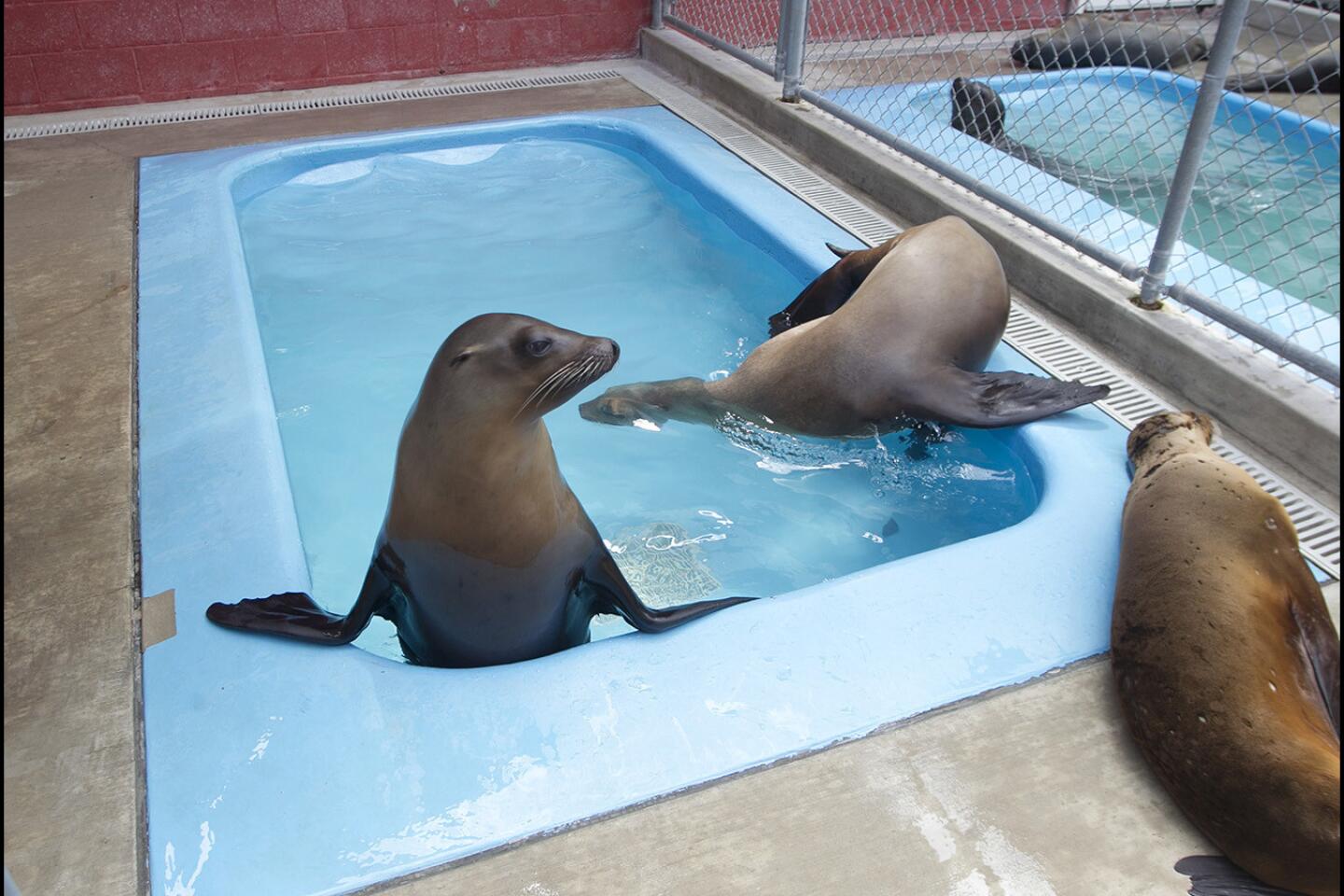Pacific Marine Mammal Center still treating poisoned sea lions
Staff at Laguna Beach’s Pacific Marine Mammal Center are still dealing with the effects of a domoic acid outbreak in the Pacific Ocean.
Since April 4, the center has rescued 40 adult female sea lions infected with domoic acid, 26 of which have died, Krysta Higuchi, the center’s public relations coordinator, said.
As of Wednesday, the center had three poisoned adult sea lions in its care, who were all eating, Higuchi added.
Veterinarians have injected sea lions with fluids to flush out the toxins.
Within a 10-day span in April, center staff rescued 15 sea lions poisoned with domoic acid, a naturally-occurring neurotoxin produced by algal blooms.
The toxin inhibits nerve transmission in the animal’s brain. Sea lions can become lethargic, disoriented and suffer seizures.
Seven adult females have given birth prematurely due to the domoic acid poisoning, but none of their offspring has survived, Higuchi said.
“Since everything that the mom eats is transferred to the pups, the pups are filled with toxins,” Higuchi said. Six of the seven mothers survived and were released back into the wild.
Sea lions and other marine mammals ingest the toxin when they eat fish such as sardines and anchovies. Pregnant adult females are most susceptible to domoic acid poisoning because they eat twice the usual amount as they await the birth of their pup, Higuchi told the Daily Pilot last month.
The blooms are caused by high concentrations of free-floating, single-celled plants in the ocean — phytoplankton — that produce toxins that spread into the marine ecosystem, according to the Monterey Bay National Marine Sanctuary website.
Of approximately 5,000 known species of phytoplankton, only a few dozen are known to produce toxic chemicals that can harm fish, shellfish, marine mammals, seabirds and humans, the marine sanctuary website said.

This bloom, which stretches from Santa Barbara south to Baja California, is larger than what Southern California is used to seeing and is harming other wildlife including birds and shellfish, said Clarissa Anderson, executive director of the Southern California Coastal Ocean Observing System at the Scripps Institution of Oceanography at UC San Diego.
Researchers use images from NASA satellites to identify locations of the toxins and to track blooms.
“If we know where the toxins are in the water, we can tell where the phytoplankton are,” Anderson said. “If we can track where the bloom is going, we can understand the impact on animals.”
A multitude of factors could be at work to create a bloom that is larger than other years, Anderson added in a follow-up email.
“There are likely chemical triggers associated with broader changes in circulation, physics, and biogeochemistry in the regional ocean that are involved,” she said. “If you combine these factors with some of the very localized effects of urban and agricultural runoff along the coast, there can be a perfect storm that leads to persistent and particularly toxic harmful algal blooms that span a large area.”
Anderson said the name “domoic acid” can mislead people because it is not connected to the water’s pH level, but has all the structural components of an amino acid.
In addition to the three sea lions infected with domoic acid, the Pacific Marine Mammal Center is caring for dehydrated and/or malnourished sea lion pups, harbor seals and elephant seal pups.
Humans are not immune from the effects of domoic acid poisoning.
Symptoms can occur within 30 minutes to 24 hours after eating toxic seafood, according to the marine sanctuary website, which cited California Department of Public Health information.
In mild cases, symptoms may include vomiting, diarrhea, abdominal cramps, headache and dizziness, the marine sanctuary website said. In severe cases, symptoms can include difficulty breathing, a loss of short-term memory, coma or death.
The annual quarantine of sport-harvested mussels along the entire California coast began May 1, according to the state Department of Public Health.
The quarantine is designed to prevent paralytic shellfish poisoning and domoic acid poisoning. Both of these toxins are linked to plankton consumed by shellfish, including mussels and clams, the Department of Public Health website said.
Commercially-harvested shellfish are not included in the annual quarantine because all commercial harvesters in California are certified by the Department of Public Health and subject to strict testing requirements to ensure that all oysters, clams and mussels entering the marketplace are free of toxins.
For updates on quarantines, call the Department of Public Health information line at (800) 553-4133.
Twitter: @AldertonBryce
All the latest on Orange County from Orange County.
Get our free TimesOC newsletter.
You may occasionally receive promotional content from the Daily Pilot.









